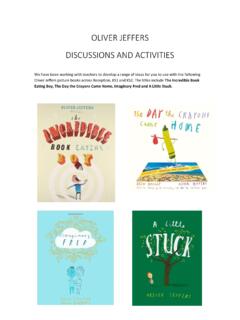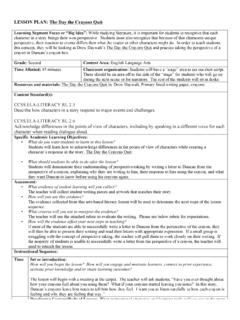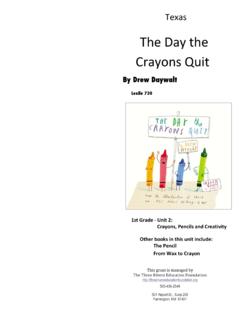Transcription of The Day the Crayons Came Home - readingzone.com
1 The Day the Crayons Came Home Discussion Themes: Friendship, Kindness, Compassion & Round the World Reception / KS1 There are lots of talking opportunities on each page, helping children read the picture. Hide crayon characters around the setting. Go and find them! Talk about how it got there? What adventures could it have had? Choose another crayon colour; children can discuss what could have happened to it? PSHE Children can discuss how the different Crayons felt, picking out the emotions: frightened, neglected, lost, abandoned. Why did they feel this way? Move on to discussing times when the children have felt these emotions.
2 How do different colours make you feel? What emotions are linked to them? red could represent anger, love or warmth. Activities Reception Geography: Identify places the Crayons visit around the world. EAD: Design a lovely home for your Crayons . What would you include? What would they need to be happy? Literacy: Children to write diary entries from a travelling crayon. Draw a story board - first/ next/then/finally sequence. Each child creates a page to make a class book. Drama: Tell the story as puppets - you could stick goggly eyes onto chunky Crayons ? Or children act out the particular page? Film it.
3 KS1 Literacy Choose another crayon colour - what could have happened to it? Write an additional page to the story with a letter describing the experience of a crayon not in the original story. Choose your favourite Crayons from the story. Write in the 1st person a review of this crayon and why you like it. Look at a pack of Crayons explore what we use each colour for. Children to write a sentence from the point of view of each crayon or a selection of colours: I m red crayon and my job is colouring in the apples and tomatoes Develop work from Oliver Jeffers earlier book, The Day the Crayons Quit, called The Day the Toys Quit.
4 Take a photo of under a child s bed of the lost toys that are often forgotten. Bring in a toybox and take out the main what are the toys left at the bottom? What is the story of these toys? Children to explore what happens to the lost toys. They can choose a different toy to write a complaint postcard to Duncan about. This could be further developed into an anthology of letters that could become another book. They could also write about Toys that have been completely lost, the ball at the park, teddy on the bus Children could write letters from these toys about what happened to them: The Day the Toys Came Home.
5 KS2 Geography (maps and atlases) Using the clues and places referred to, locate the continents that Neon Orange has visited. On his way home to Duncan (Cleveland) which continents, oceans would he pass through? Children could also work out the continents/oceans that Neon Orange would pass through if he was return to the child s own home. Explore the equator, northern hemisphere and southern hemisphere whist looking at Neon Orange Crayons journey. Neon Orange refers to or is shown in several countries (China, Canada, France) cities (Newcastle) and places of interest (The Amazon Rainforest, Pyramids of Giza). Children can find these on a map, looking at their longitude and latitude.
6 With a little research on one of the places Neon Orange visits, children could create a fact file of the location or write a non-chronological report. Art (colours) Explore mixing colours, colour wheels, primary and secondary colours, complimentary colours and colour clashes. Sienna and Pea Green introduce us to different colour names. Using their own knowledge, music and stories, generate a rainbow of colours ( Emerald from the Wizard of Oz, Ebony from Snow White, lyrics from Joseph and the Amazing Technicolour Dream Coat). Children can use these new colour-words in their writing and also discover where the words come from; is there a link between the colour name and something real?
7 Spelling, Punctuation and Grammar Explore abstract nouns through the feelings of the Crayons that are expressed in the letters. This could be extended by considering Duncan s emotions on receiving the letters and the crayon s feelings as they return home (or, in the case of Pea Green, try to leave for an adventure, and Neon Orange, get gradually closer to home). Identify the features that make the letters informal language chatty style, contractions, capitalisation for emphasis, use of phrases such as Noooo! and Huh? Re write one of the postcards in Standard English. English (Creative Writing) Diary of a crayon: Select one of the Crayons .
8 Using the details in the letter along with own imagination, write a diary extract for the crayon, focusing on his thoughts and feelings. What had the crayon been upset/angry about? Why has the crayon decided to come home? What does the crayon hope will be different? Children could also take a crayon that has not been used and write their own letter to Duncan. Letter of complaint/apology: write a letter of complaint from the Crayons to Duncan, addressing the frustrations that had led to them leaving and making a clear request for change upon their return ( The Day the Crayons Quit would be a helpful book to support this activity).
9 Alternatively, write a letter of apology from Duncan to the Crayons . How can Duncan change his actions? He should think of various things he could do so that all of the Crayons will be happier on their return. Poetry: Poetry that focuses on the abstract nouns ( sadness, anger, regret) from the story would allow children to explore personification, simile and metaphor through free verse. Think about where the emotion resides, what it would look like, how it would move and sound. In addition children could write poems based around the colours they have learned. This could be a descriptive poem called a general name Blue but then uses all of the other shades cobalt, cerulean, sapphire, navy, aegean, cornflower possibly in an order like light to dark.
10 Children could explore the use of the actual shades in their published poems. Alternatively they could select any of the colours that have explored and write a poem to help someone who has never seen that colour (an extension if this would be to describe the colour through poetry to a blind person, encouraging the use of senses other than sight). Story (adventure) Neon Orange/Pea Green: Neon Orange has been on a pretty magnificent adventure and Pea Green is desperate to go on an adventure too (if it stops raining). Children can write a story where the crayon goes on an adventure to a particular place and then returns home.










